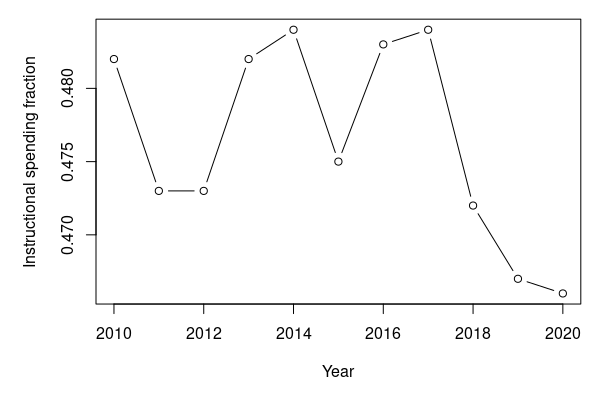March 16, 2022 Faculty Motion on Compensation
We call on the College to secure the future of Oberlin by making a greater investment in the faculty.
Rationale The future of Oberlin depends on having a strong and engaged faculty to deliver an educational program that attracts students to the College. All employees matter, and extracurricular activities will always be an important part the life of a student, but we rise or fall based on the quality of the educational experience that we offer. Oberlin cannot expect to provide academic and musical excellence if we cannot attract and retain outstanding faculty, or if the faculty we have are demoralized. Oberlin has many needs and there are countless ways we could spend money, but investing in the educational experience, through the faculty, should be front and center.
In its recent letter, the Board stated that spending on instruction and research, as a share of the budget, has remained “almost the same” since 2010, but the percentage has actually dropped from 48.3% to 46.6% over the decade, with the difference between those two percentages representing close to $3M in annual spending that is not, today, supporting instruction (e.g., through faculty compensation).[1] This graph shows the most recent 11 years for which data are publicly available.

In 2013 the Board of Trustees made a commitment to improving faculty compensation, stating “Oberlin College should set a goal of achieving salary parity (meaning the median of the salary range) with the Sweet Sixteen Schools in each continuing rank (Professor, Associate
Professor, and Assistant Professor)” and “Oberlin College should establish a strategic indicator to monitor annual progress toward this goal.” Having an annual evaluation of where we stood relative to that goal indicated a serious commitment to investing in the quality of the faculty, but that commitment seems to have been abandoned.
For many years (2001 – 2015) Oberlin used a payout rate from its endowment averaging over 5.5%. The Board of Trustees determined that having such a high payout rate, well above the average used by peer institutions,[2] was not sustainable and has set the FY22 payout rate at 4.4%, a figure that is to be reduced by 0.1% per year until it reaches 4.0%. However, reducing the payout rate to 4.4%, heading lower, has resulted in such severe budgetary constraints that faculty compensation has fallen well behind inflation, to say nothing of comparison to peer institutions.
It is true that the AAPR One Oberlin report – where one repeatedly reads of the academic and artistic excellence that must be provided by the faculty – recognized the need for budgetary reductions and some savings in benefit costs across employee groups, but the GF approval of that report was not intended to signal acceptance of a healthcare plan that, unique among our peer set, has no options. The College had already reduced retirement contributions and to follow this by the move to a CDHP-only plan will only make recruitment and retention of faculty more difficult in the years ahead.
Any spending today is implicitly taking money from the future of the College, but saving money for the future must be balanced against the needs of building a strong College today. The cost to faculty morale and to the ability to hire and retain quality faculty must be considered. We believe that the College has the capacity to invest in its future, via the faculty. For example, increasing the payout rate by 0.3% would provide roughly $3M/year (which, coincidently, is roughly the amount that has been removed from instruction and research support in recent budgets).
We know that the College’s resources are limited and that the demographic situation is going to get worse in the coming years, with the number of 18-year-olds declining. We think it is better to enter those years as a top-tier, if somewhat poorer, school than as a lower-tier, but relatively wealthier, school.
[1] For example, if spending on instruction and research were 48.3% rather than 46.6%, that difference could fund a faculty salary increase of over 8%.
[2] As a point of comparison, the 2021 NACUBO-TIAA Study of Endowments found that private colleges and universities have had an average payout rate of 4.58% over the past decade (https://www.nacubo.org/Research/2021/Public-NTSE-Tables).

